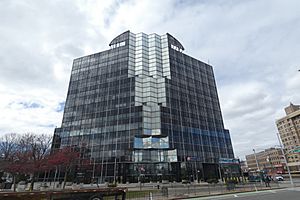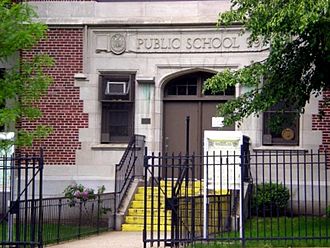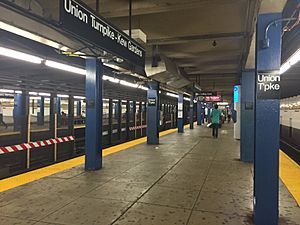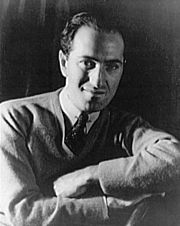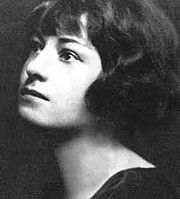Kew Gardens, Queens facts for kids
Quick facts for kids
Kew Gardens
|
|
|---|---|
|
Neighborhood of Queens
|
|
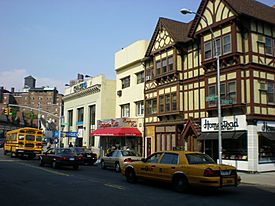
Businesses on Lefferts Boulevard
|
|
| Country | |
| State | |
| City | |
| County/Borough | |
| Community District | Queens 9 |
| Named for | Royal Botanic Gardens, Kew |
| Population
(2020)
|
|
| • Total | 24,371 |
| Race/Ethnicity | |
| • White | 40.0% |
| • Hispanic | 27.2% |
| • Asian | 18.3% |
| • Black | 7.8% |
| • Other/Multiracial | 6.7% |
| Economics | |
| • Median income | $61,287 |
| Time zone | UTC−5 (EST) |
| • Summer (DST) | UTC−4 (EDT) |
| ZIP Code |
11415
|
| Area codes | 718, 347, 929, and 917 |
Kew Gardens is a neighborhood in the central part of Queens, one of the five boroughs of New York City. It is bordered by several major roads and other neighborhoods. To the north, you'll find Union Turnpike and the Jackie Robinson Parkway. The Van Wyck Expressway and 131st Street are to the east. Hillside Avenue forms the southern border. To the west are Park Lane, Abingdon Road, and 118th Street.
Kew Gardens is near Forest Park to the west and Forest Hills to the northwest. Flushing Meadows–Corona Park is to the north. Other nearby neighborhoods include Richmond Hill to the south, Briarwood to the southeast, and Kew Gardens Hills to the east. The neighborhood has a ZIP Code of 11415 and is looked after by the New York City Police Department's 102nd Precinct.
Contents
History of Kew Gardens
How Kew Gardens Began
Kew Gardens is one of seven planned "garden communities" built in Queens. These communities were developed between the late 1800s and 1950. In 1868, an Englishman named Albon P. Man bought much of this land. He developed the Hollis Hill area to the south. However, he left the hilly northern part undeveloped.
Maple Grove Cemetery opened on Kew Gardens Road in 1875. A Long Island Rail Road (LIRR) station was built there for people visiting the cemetery. It was first called Hopedale. In the 1890s, Man's family created the Queens Bridge Golf Course on the hills. In 1908, the LIRR moved its main line, cutting through the golf course. The golf course was then closed.
A new LIRR station was built in 1909 on Lefferts Boulevard. Man's heirs decided to create a new community. They named it Kew Gardens, after the famous botanical gardens in England. The buildings in this area were designed in English and neo-Tudor styles. These styles are still common in the neighborhood today.
Growing into a City Area
In 1910, the land was sold off in pieces. Over the next few years, streets were built, land was leveled, and water and sewer pipes were installed. The first apartment building, the Kew Bolmer, was built in 1915. A clubhouse followed in 1916. Kew-Forest School, a private school, opened in 1918.
By 1920, the Kew Gardens Inn opened near the railroad station. It offered rooms and meals for residential guests. Many elegant one-family houses were built in the 1920s. Apartment buildings like Colonial Hall (1921) and Kew Hall (1922) also appeared. By 1936, there were more than twenty apartment buildings.
In 1933, the Grand Central Parkway opened. Two years later, the Interboro (now Jackie Robinson) Parkway also opened. These parkways helped connect Kew Gardens to other parts of New York. They were built using existing road space, so no houses had to be torn down.
Around the same time, the new Queens Boulevard subway line was being built. This line made it possible to travel quickly to Midtown Manhattan. People bought land near the subway route, causing real estate prices to go up. Older buildings were replaced with new apartment buildings. The subway line was extended to Kew Gardens–Union Turnpike on December 30, 1936.
After the subway was completed, property values around Queens Boulevard increased a lot. The area became a busy center with apartment buildings and businesses. It was even called the "Golden Area" by the Chamber of Commerce.
Recent Years
Kew Gardens has a rich history, but its buildings do not have special landmark protection.
In 1950, two Long Island Rail Road trains crashed in Kew Gardens. This accident happened between the Kew Gardens and Jamaica stations. It was the worst train accident in LIRR history.
In 1964, the neighborhood was in the news because of the Kitty Genovese case. This event led to studies about the "bystander effect". This is a social idea about why people might not help someone in trouble when others are around.
What Kew Gardens is Like Today
Kew Gardens is a busy residential area. It has a mix of expensive one-family homes, apartments, and co-ops. Many buildings are four to ten stories tall. Some are rentals, while others are Housing cooperatives (co-ops). There are also Mitchell-Lama buildings, which offer affordable rent. One such building on 83rd Avenue is 32 stories high.
Near the borders of Richmond Hill, Briarwood, and Jamaica, you can find smaller attached houses. Many of these are homes for two or three families. Expensive single family homes are located near Forest Park. However, some owners are selling their homes to developers. These developers are building new apartments or larger, more expensive houses. This is changing the neighborhood's population.
Many airline workers live in Kew Gardens. This is because it's close to John F. Kennedy International Airport. The Q10 bus line goes there, and airlines like Delta Air Lines and JetBlue Airways have shuttles for their staff.
The main shopping area in Kew Gardens is Lefferts Boulevard. It runs between Austin Street and Metropolitan Avenue. A popular spot is the Kew Gardens Cinemas. This 1930s art deco movie theater now has six screens. It shows a variety of movies, including independent and foreign films. Lefferts Boulevard also has the only bookstore in central Queens, Kew & Willow Books.
Interesting Places to Visit
Forest Park is the third largest park in Queens. It is located to the west of Kew Gardens. The park's hills were formed by a glacier about 20,000 years ago. Native American tribes like the Rockaway, Delaware, and Lenape lived here before European settlers arrived. The park has the largest continuous oak forest in Queens. Inside the park, the Forest Park Carousel is a historic landmark.
Besides Maple Grove Cemetery, the Ralph Bunche House is also a historic site. It is listed on the National Register of Historic Places.
The county's main government building, Queens Borough Hall, is at the northern end of the neighborhood. It is on Queens Boulevard. Next to Borough Hall, there is an old New York City Subway train car. It's a retired R33 (Redbird) subway car on a fake track.
People of Kew Gardens
Kew Gardens is a very diverse neighborhood. In 2020, about 24,371 people lived here. The population includes many different groups:
- White: 40.0%
- Hispanic: 27.2%
- Asian: 18.3%
- Black: 7.8%
- Other/Multiracial: 6.7%
The median household income in Kew Gardens was about $61,287 in 2017. Most residents are young and middle-aged adults. About 22% are under 18, 30% are 25-44, and 27% are 45-64.
Changes in Population
The number of Hispanic and Asian residents in Kew Gardens has grown since 2000. After Second World War, many Jewish refugees from Germany settled here. This is why there are many active synagogues in the area today.
After 1965, many Chinese immigrants moved to Kew Gardens. About 2,500 Iranian Jews arrived after the Iranian Revolution of 1979. Immigrants from China, Pakistan, Iran, Afghanistan, Israel, the former Soviet Union, India, Bangladesh and Korea also settled here in the 1980s and 1990s.
Today, Kew Gardens has a growing population of Bukharian Jews from Uzbekistan. There is also a large Orthodox Jewish community. Many immigrants from Central and South America, and Japan also call Kew Gardens home. The First Church of Kew Gardens now offers Korean-language services. In recent years, young professionals from Manhattan have moved here. They enjoy the green spaces and spacious apartments.
New apartment buildings and multi-family homes have also brought more changes. Immigrants from Latin America, Guyana, South Asia, East Asia, and the Middle East (especially Israel) have moved into these new homes. The food in Kew Gardens shows this diversity. You can find Russian, Italian, Indian, Pakistani, and Uzbek restaurants. Many religious groups can also find markets that sell food for their needs.
Economy of Kew Gardens
Kew Gardens has many local businesses and restaurants. These are mostly found on Lefferts Boulevard, Metropolitan Avenue, Austin Street, and Kew Gardens Road. The courthouse in the area also brings business. The cost of living in Kew Gardens was about $62,900 in 2015.
Pilots and flight attendants often stay in Kew Gardens between flights from John F. Kennedy International Airport and LaGuardia Airport. This also helps the local economy. Saudi Arabian Airlines has an office at 80–02 Kew Gardens Road.
Education in Kew Gardens
Kew Gardens and Woodhaven have fewer college-educated residents than the rest of New York City. About 34% of adults aged 25 and older have a college degree or higher. However, 22% have less than a high school education.
Students in Kew Gardens and Woodhaven are doing well in school. The percentage of elementary school students who are good at math went from 34% in 2000 to 61% in 2011. Reading skills also improved from 39% to 48% in the same time. Fewer elementary school students miss many days of school here. About 17% miss twenty or more days, which is lower than the city average. Also, 79% of high school students graduate on time, which is higher than the city average.
Schools in the Neighborhood
Some notable schools in Kew Gardens include:
- Yeshiva Tifereth Moshe
- Bais Yaakov of Queens
- Yeshiva Shaar Hatorah
The only public school in Kew Gardens is PS 99. It has special programs for gifted students, like the Gifted and Talented program.
Local Libraries
The Queens Public Library has two branches close to Kew Gardens:
- The Richmond Hill branch at 118-14 Hillside Avenue
- The Briarwood branch at 85-12 Main Street
Getting Around Kew Gardens
The neighborhood has good public transportation. You can use the New York City Subway's E, F <F> trains trains at the Kew Gardens–Union Turnpike station. The J and Z train trains stop at the 121st Street station. The Long Island Rail Road also has a stop at the Kew Gardens station.
Several New York City Bus routes serve the area, including Q10, Q37, Q46, Q54, Q60. There are also express bus routes that go to Manhattan.
If you are driving, you can reach Kew Gardens from major roads like Interstate 678 (Van Wyck Expressway), Grand Central Parkway, Jackie Robinson Parkway, Queens Boulevard, and Union Turnpike. All these roads meet at the Kew Gardens Interchange.
Famous People from Kew Gardens
Many interesting people have lived in Kew Gardens, including:
- Burt Bacharach (1928-2023), a famous pianist, composer, and producer.
- Ralph Bunche (1903–1971), a diplomat and Nobel Peace Prize winner.
- Charlie Chaplin (1889-1977), the well-known actor, lived here for a few years.
- Rodney Dangerfield (1921–2004), a comedian.
- George Gershwin (1898–1937), a famous composer.
- Miriam Hopkins (1902–1972), an actress.
- Anaïs Nin (1903–1977), an author.
- Dorothy Parker (1893–1967), a poet.
- Will Rogers, Sr. (1879–1935), an actor.
- Jerry Springer (1944-2023), a talk show host.
- Paul Stanley (born 1952), a musician from the band Kiss.
- Dick Van Patten (1928-2015), an actor known for Eight Is Enough.
Images for kids





